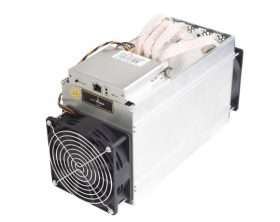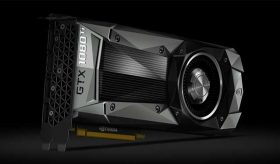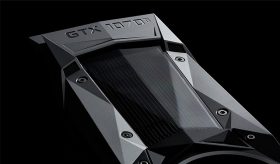How to Mne DigiByte
DigiByte (DGB) is a coin focused on providing its users with high levels of security, decentralization and speedy transactions. Transactions are 40 times faster than Bitcoin’s. What excites us about DGB is that it’s mineable with both GPU cards and ASIC machines, through five different algorithms. The current article is going to present you all the key moments when speaking of how to mine DigiByte.
Here’s a summary of what you can expect to learn from us:
- How to pick and which is the best hardware
- How to configure your devices and software
- What are the best DGB mining pools
As with most other coins, you can avoid the hassle and opt for cloud mining. More on that later in the article. Now, let’s continue with the core aspects.
Why mine the DigiByte?
Speed, safety and different algorithm choices – all key markers that should pique your interest. Another crucial benefit you shouldn’t ignore is the freedom of choice with what hardware you can mine. With this coin, you gain access to a secure blockchain environment, where you can protect any data or information of interest, from being hacked or duplicated. All these added benefits amount to an exciting opportunity which many crypto-experts believe, has untapped potential for further growth and uplift in value. Are you eager to get started? Great, because in the next section, we’ll share with you how to best go about mining DigiByte.
Best way to mine DigiByte
DigiByte’s main advantage, as we already mentioned, is it’s multi algorithm support for mining. What this means for the user, is that they can choose a hashing function to use, depending on the hardware they have available. The best way to mine DGB is by using ASICs. General rule of thumb, if you can mine it with an ASIC, that’s the most profitable way. In case you have GPUs available, feel free to use them as well. That’s the main idea of the developers, freedom of choice and no necessity to invest in new, expensive DigiByte hardware.
Below we’ve summarized which functions you can use for your specific device:
- SHA-256, Scrypt and Qubit – your best option for using ASICs
- Skein and Groestl – GPU’s are the way to go, we’d recommend Nvidia ones
To maximize your profits our suggestion is to join a DGB mining pool. By teaming up with others you’d be able to receive profits more frequently and steadily. Compared to mining solo, which depends a lot on luck, pool mining is the more lucrative option in the long term.
What do you need to start mining DigiByte?
DigiByte’s mining starts with a proper choice of hardware, correlating to the hashing function you’ve picked out (ASIC or GPU). In addition, you would need to supply your devices with a reliable internet connection, so you have access to the blockchain and are able to mine. Have in mind that each device goes through roughly 15GB of data per month. Another thing to think of is your power capacity. You would need to calculate the power draw from your devices and keep in mind where you’re going to run them. Afterwards, all you need to do is choose a wallet and you’re good to go.
In summary, here are the key points:
- Choose the correct hardware for the job – ASIC or GPUs
- Reliable Internet connection
- Electrical capacity (ASICs use around 1300W per unit and GPUs 250W)
- Wallet choice – we recommend the official one
What Else to Consider?
When we first met the enchanting world of DigiByte mining, we were shocked by the heat and noise that mining rigs and ASICs produce. That is why we want you to take those issues into consideration. You can find a lot of cooling and soundproofing methods online, some better than others. Not to waste your time and money, our mining experts have compiled a handy list that is going to help you find the best solution for you. Visit our dedicated Ventilation, cooling decisions and noise solutions. One more thing to consider. We already spoke about choosing a wallet. What’s special about DigiByte is that the developers have focused on user experience, and thus provide you with different options to choose from, namely:
- desktop one – for Windows, Linux and Mac;
- web extension – for Chrome;
- mobile wallet – for Android and iOS;
Best hardware to buy
In this section, we are going to offer you some suggestions on how to choose proper mining hardware and also, give out recommendations for the best models according to us. You can explore your options
Recommend DigiByte Mining Hardware
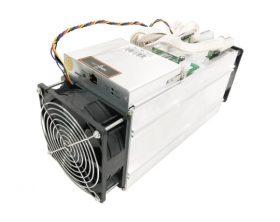
- 14.5 TH/s, 1320W
- 350mm(L) x 135mm(W) x 158mm(H)
As you may have noted, the most profitable choice would be to buy an ASIC machine. However, if you choose to mine via GPU, the more profitable option is the Nvidia video card. Choosing between both depends both on your budget and your end goals.
Setup software and hardware / Configuration
In this section, we’ll explain in detail how to configure your ASIC or GPU rig with our step-by-step guide. Before we do that, however, lets quickly set up your wallet:
Step1: Follow installation instructions and allow firewall access
Step2: Open your wallet
Step3: Encrypt with a password
Step4: Backup your wallet and securely store it
Step5: Let the wallet finish syncing
GPU configuration for Nvidia
-
01. Choose a Mining Pool From the Table Below
Digihash
(Scrypt)
.Server locations:
.Reward system: PROPAverage fee: 1.0%Our choiceIspace
(SHA-256d)
.Server locations:
.Reward system: PROPAverage fee: 0.0%Miningfield
(Skein)
.Server locations:
..Reward system: PPLNSAverage fee: 0.0%For more information about about mining pools, rewards and fees please visit our dedicated mining pools website.
-
02. Create a worker:
Sign up to the mining pool in their website.
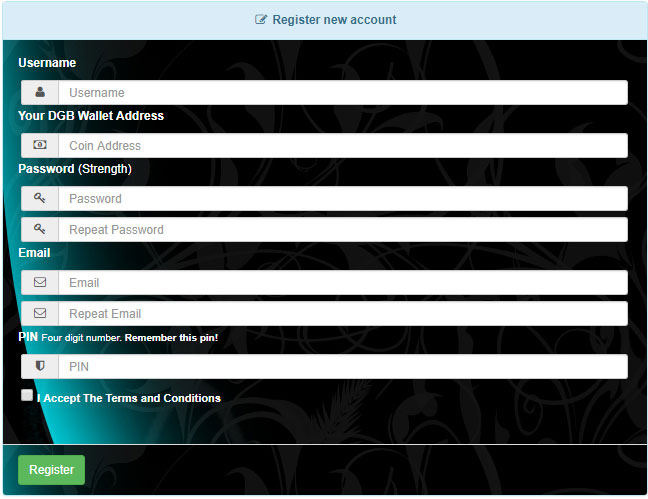
From My account menu > My worker you can add the user name and password in the boxes of the pop-up window:

-
03. Software configuration
Download the DigiByte mining software – CCMiner for Nvidia cards. You need to unzip and extract the archive into folder.
-
04. Create a .bat file
Open a Notepad, save the file in the same folder with extension .bat and paste this configuration in it:
ccminer-x64 –a skein -o stratum+tcp://eu.miningfield.com:3398 -u username.worker -p yourpassword -
05. Run the .bat file
The screen should looks like this
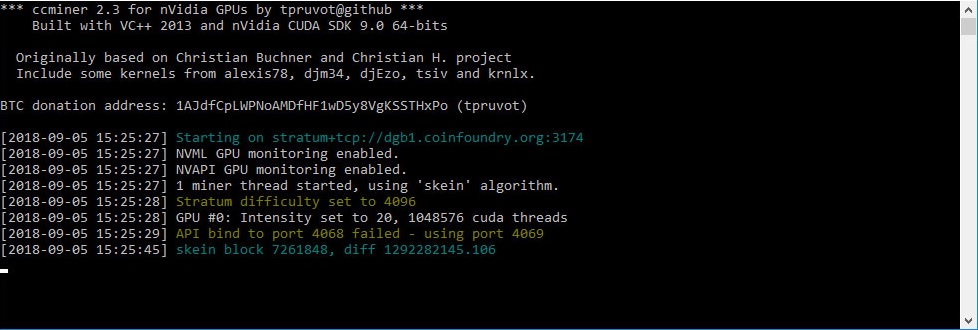
ASIC configuration
-
-
01. Create a wallet address
Create wallet address following the example from the GPU section.
-
02. Choose an ASIC (SHA-256, Scrypt or Qubit)
Here are a few examples:
- Antminer S9i – 14 TH/s (SHA-256)
- Antminer L3+ – 504MH/s (Scrypt)
- Antminer L3++ – 530 MH/s (Scrypt)
- Baikal Giant X10 – 10 GH/s (Qubit)
-
03. Configure the ASIC
The ASIC should be plugged into an electric power and also connected to the network using an Ethernet cable. The ASIC will create heat, noise and air flow, they should be considered as industrial equipment.
You must open your ASIC miner configuration. Adjust it accordingly as follows (in case of any doubts, refer to the user manual of your ASIC):
URL and PORT: stratum+tcp://digihash.co:3037
Username: Your_Wallet_Address
Password: Your_Password
-
04. Run the miner
Create wallet address following the example from the GPU section.
-
Launch the miner and check miner status page after 5 to 10 minutes. From this moment on, you’re officially a DigiByte miner. We wish you good luck in your endeavor!
DigiByte Cloud Mining
DigiByte cloud mining gives you the opportunity to skip all we’ve said so far. It’s basically rented mining – you sign a contract with a provider (a third party) who, for a fee, does all the dirty work for you. Depending on the conditions in your contract, they can operate with your coins for you as well.
You’re going to miss out on all the fun of mining, but you’ll also have more time to spend on other aspects of your life. To get started, you would need to conduct a proper provider research, as there are many alternatives, but as with any other business sphere, there are scams and risks out there.
You would need to first define your mining expectations, decide on a coin and start looking. We have also provided you with an informative article, providing you with knowledge about the pros/cons and how to choose a cloud mining provider. Follow the link. If you simply want to have some suggestions to directly check on, we recommend the following providers:
If you’re interested in the details on how cloud mining works, follow this link: cloud mining
DigiByte mining calculator
Our DigiByte mining calculator can provide you with a rough estimation about your potential profits. To use it, you would need only to enter a few values such as: hash rate, power consumption, price per kW/hour, pool fee. You’ll see the estimated reward divided into different time periods: hourly, daily, weekly, monthly and yearly. Check the mining calculator and verify you estimated reward today.
Disclaimer: Do keep in mind that all values provided in our calculator are estimates, based on the specific point in time of your calculation. As network difficulty, coin price and other factors change constantly, we cannot guarantee your earnings in the future.
FAQ
How long does it take to mine 1 DGB?
Depends on your hardware. For example, if using an Antminer L3++, it will take you about 2 or 3 days to mine 1 coin.
How many DGB you can mine in one day?
Using the example from the previous question, it amounts to about 0.39 coins per day.
Is it worth it?
Short answer is – it depends. You can use our mining calculator to get an estimate and decide for yourself.
Can I mine by raspberry pi?
Always possible, but not recommended.
Is it legal?
Mining is banned in Algeria, Bolivia, Ecuador, Bangladesh, Nepal and Macedonia. It’s illegal to use it as a payment tool in Vietnam, Indonesia and Thailand, but in all the other countries in the world is perfectly legal to trade and mine the DigiByte coin.
Is it safe?
Depends on the security and the privacy of the coin – for DigiByte, we might say it is.
About DigiByte
DigiByte is a global blockchain, focused on cybersecurity for payments and applications. What makes DGB’s team forward thinking is their aim to provide high levels of security and fix many common vulnerabilities on the Internet. IOT devices are also able to benefit from DigiByte’s blockchain technology and the coin’s developers are exploring the possibility of using artificial intelligence for automation and data analysis. Transactions are limited in their size, which leads to increased speed and efficiency, while maintaining security.
The coin sets itself apart with multiple blockchains and assures decentralized transactions, mining and blockchain distribution. It’s a highly scalable platform with industry-leading speed of transaction, which merits mass adoption. The platform can also store sensitive data, because it can’t be hacked or duplicated. It has also implemented smart contract and decentralized applications support. Each device, connected to the DigiByte network becomes a node, which helps with relaying transactions.
DigiByte Team
DigiByte was created by Jared Tate in 2014. It has been tested for 4 years and it hasn’t had any sort of pre-mine, initial funding and has never launched an ICO. Their technology has been presented to governments, enterprises and banks to attract their attention to the benefits of decentralization. It has a large community, engaged in the blockchain’s space, which is adding users every day.
